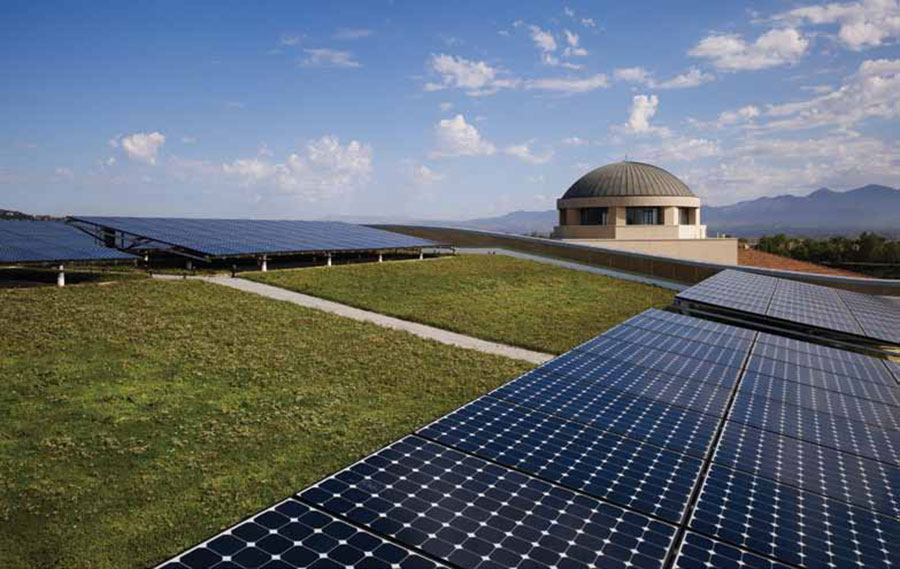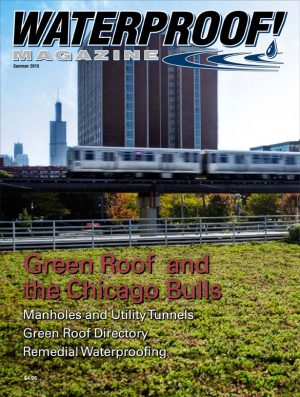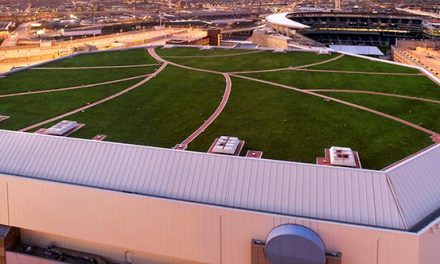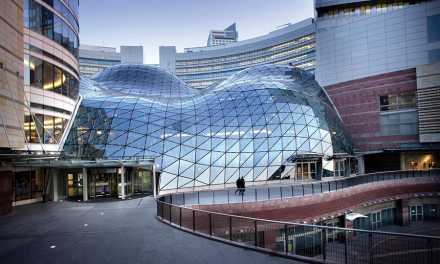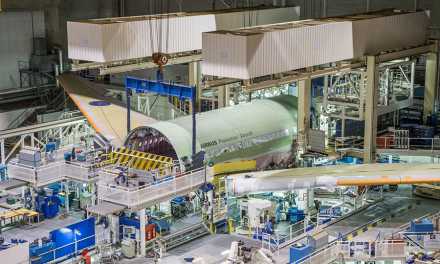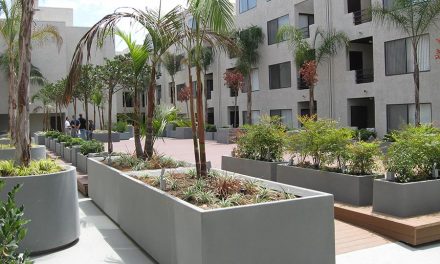The Soka University Performing Arts Center roof combines green and solar. On a recent 100 degree day, the green roof was 50 degrees cooler than the nearby pavers, allowing the photovoltaic panels to perform significantly better.
The term “green roof” can cause some confusion. For some, the term conjures up images of green vegetation on a building’s roof. For others, it refers to the concept of making a building’s roof green from an environmental standpoint with reflective roofing or energy-creating solar panels.
New evidence indicates that the “greenest roof” is one that combines a vegetated green roof system with roof-mounted photovoltaic panels. Understandably, interest in these combination systems is high, despite the complex design and installation requirements. At least three companies in the U.S. have a proven track record with these roofs, and they agree that successful installation requires careful planning, the right materials, and top quality craftsmanship.
Market Potential
Jon Hillis, vice president at Prospect Waterproofing, refers to the combination of green roof and solar by the acrynym GRIPV, for Green Roof with Integrated PhotoVoltaics. He says, “GRIPV systems integrate solar, or photovoltaic systems, directly into the green roofing on a project. Although this system is not prevalent in the US, they are being installed in Germany as competition for roof space between these eco-friendly installations increases.”

Educated at Penn State University, Hillis has over 25 years of commercial roofing experience and is a senior estimator for one of the largest green roofing installers in the Washington D.C. area. The District of Columbia is leading the nation in green roof construction, and is also a leading location for solar installations.
We have witnessed the explosion in both green roofing and rooftop solar,” he reports.
“Through 2012, the District of Columbia has installed almost 1.5 million sq. ft. of green roofing.” When compared to available roof space, that’s twice the amount installed in Chicago and three times that installed in New York in 2012.” He predicts the District will install an additional 2 million sq.ft. of green roofing on public and private buildings by 2018, and may soon compete directly with solar panels in the limited available roof space.

“This competition between green roofing and solar is not necessary as these installations are not mutually exclusive,” he says, adding that both systems work more efficiently when installed on the same roof.
Benefits
At first glance, it seems solar panels would deprive green roof vegetation of rainfall and sunlight. However, rooftop photovoltaic arrays can actually improve the performance of both systems.
“The main benefit of a GRIPV system is the symbiotic relationship between the PV system and the sedum plants,” says Hillis. “If shade-specific plants are installed in the location where the solar is being installed, the warmth of the solar panels provides for a longer growing season for the plants and the plants reduce the temperature beneath the solar module allowing them to operate up to 10% more efficiently.”
ZinCo, a green roof supplier headquartered in Australia, conducted a three-year field test comparing PV output on a German warehouse roof. Some panels had a vegetaged roof below, others a standard bitumen membrane. The data indicated the GRIPV system was 4% more efficient.
Jorg Breuning of Green Roof Technology, who pioneered the GRIPV concept, says actual performance gain is closer to 16%. He explains: “Heat is the enemy of energy production. Any time atmospheric temperatures on a roof begin to rise, PV [photovoltaic] elements lose their efficiency. They will actually shut down if temperatures rise too high.” His company was one of the first to investigate if they could counteract this negative phenomenon by combining solar modules with an extensive green roof.

What Breuning and others discovered was that through transpiration of the plants, green roofs are significantly cooler, enabling photovoltaic cells to operate at peak efficiency. This effect is especially noticeable on hot summer days. Additionally, there is evidence that green roof vegetation reduce the amount of dust typically found on bare roofs. And less dirt on the photovoltaic panels equals better performance and less maintenance.
As noted above, plants benefit from the arrangement too. The retained heat of the panels keep plants warmer at night, which means better growth and a longer growing season. The shade-tolerant plants under the panels create areas of biodiversity, where plants and animals adapted to less water and light can thrive. And studies have shown a more diverse roof is a more stable roof.
In addition to these benefits, a GRIPV system still has the advantages of the component systems: Reduced demand on the power grid, reduced urban heat island effects, reduced stormwater run-off, and extended roof life.
Installation
Hillis say, “GRIPV should be seriously considered, and this should be done in one simultaneous installation .” His reasoning is that if a rooftop solar array is installed after completion of the green roofing, the added cost of removing and reinstalling the soil and vegetation can increase the cost of the photovoltaic system $1 to $3 per watt. These costs will vary depending on the region, size of the project, soil depth, and plant replacement costs, but may be enough to make these retrofits cost-prohibitive. For this reason, he recommends installing a complete, turn-key, GRIPV system from the beginning, whether it’s a green re-roofing project or new solar installations on existing properties.
Fortunately, as GRIPV projects become more common, manufacturers have begun offering products to simplify installation. For instance, Green Roof Technology markets Sun-Root System, modular green roof tray that includes elevated solar panel mounts. Most solar panels can be fastened directly to the modules. When covered with the prescribed amount of growing medium, the soil supplies enough ballast to hold the panels securely in place without the roof membrane penetrations that would normally be necessary for anchoring.
ZinCo, the Australian green roof supplier, has developed a similar system, which fits around the legs of the solar array. The height of the Solar Base Frames creates enough distance between the substrate layer and the solar panels to provide plants with enough sunlight and rainwater, and like the other system, uses the weight of the growing medium to hold the panels in place.
Others have successfully installed GRIPV systems using traditional installation methods and careful detailing. The Soka University project used the standard modules from LiveRoof.
Conclusions
As solar panels and vegetated roofs become more popular, designers and developers should realize that these systems are complementary, not competing. Combining rooftop solar panels with a green (vegetated) roof can offer financial, environmental and architectural benefits that may last for the life of the building.
The energy savings provided by vegetated roofs, together with the boost effect they give to photovoltaic performance, can allow owners to enjoy not only the aesthetic and psychological benefits of a living roof but also significantly lower energy bills.
Winter 2015 Back Issue
$4.95
Options for Deep Foundations
Livable Basements
Integrating Green Roofs and Solar
Commercial Structural Repair – By Bob Thompson
AVAILABLE AS DIGITAL DOWNLOAD ONLY
Description
Description
Options for Deep Foundations
When foundations extend more than 15 or 20 feet below grade, waterproofing becomes far more complex. Differing substrates, intense hydrostatic pressure is intense, and blindside installation techniques add to the difficulty.
Livable Basements
The right combination of waterproofing and dehumidification products can ensure below-grade living space is just as comfortable and inviting as the above-grade portions.
Integrating Green Roofs and Solar
Commercial roofers and roof designers are increasingly being asked to combine photovoltaic panels with vegetative roofing. Roof membranes, structural supports, and careful detailing are all key to a successful installation.
Commercial Structural Repair – By Bob Thompson
Carbon fiber, epoxies, and polyurethane grouts are used to repair both residential and commercial foundations, and the scale of many commercial jobs is breathtaking.
Additional Info
Additional information
| Magazine Format | Digital Download Magazine, Print Mailed Magazine |
|---|

